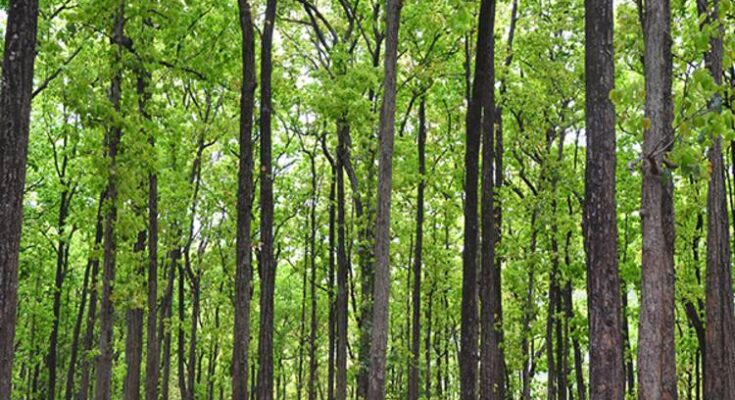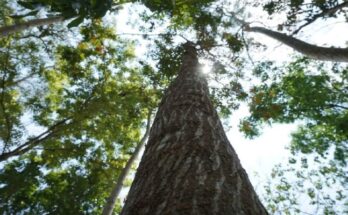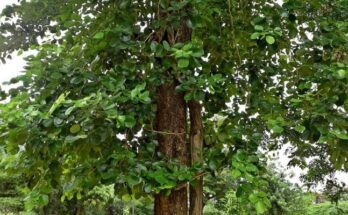|
Getting your Trinity Audio player ready...
|
Sal is revered as a sacred tree and is known as the “House of the Tribal Goddess.” It is a deciduous tree with a trunk diameter of up to 5 meters and a height of about 50 meters. Sal has dark brown bark and clean, cylindrical, and straight stems. The leaves are broadly oval at the base, tapering to a long point at the apex.
The scientific name of the Sal Tree is Shorea Robusta.
Scientific Classification of Sal Tree (Shorea Robusta)
| Scientific Classification | Scientific Status |
|---|---|
| Kingdom | Plantae |
| Order | Malvales |
| Genus | Shorea |
| Family | Dipterocarpaceae |
| Species | S. robusta |
| Clade | Tracheophytes, Angiosperms, Eudicots, Rosids |
Don’t Miss: Pine Tree | Uses | Benefits | Wood | Leaves & Flower
Know about Sal Tree Fruit (Shorea Robusta Fruit)

Sal has yellowish-white flowers clustered in terminal or axillary, massive, racemose racemes (loosely branched flowers). The fruits are 1.3–1.5 cm long, about 1 cm in diameter, and surrounded by calyx segments that fan out into five irregular wings.
Know about Sal Wood Tree

Sal is considered the “home of the tribal goddess” and a sacred tree. It has religious, medicinal, and commercial importance, and its wood is used in the furniture industry. In addition, sal is commonly used to prevent diarrhea and dysentery due to its astringent properties.
Know about Sal Tree Leaves (Shorea Robusta Leaves)

The leaves are soft green, reddish, glossy, simple, and about 10-25 cm long. Its leaves are broadly oval at the base, with the tip tapering to a long point. The leaves treat ulcers, wounds, leprosy, itching, earaches, coughs, and headaches. After cutting, the bark releases an oleoresin with astringent and cleansing properties. The resin treats menorrhagia, eye irritation, and enlarged spleen. Powdered bark, stem, or bark paste stops bleeding and promotes wound healing.
Don’t Miss: Khejri Tree | Fruits, Leaves, Uses & Benefits
9 Medicinal Uses of Sal Tree (Shorea Robusta Uses)

- Bark and leaves are useful against ulcers, wounds, coughs, leprosy, earache, gonorrhea, and headaches.
- Use the bark against dysentery, diarrhea, and vaginal discharge.
- The fruits are used for seminal weakness, tuberculous ulcers, dermopathy, and burning.
- Use for pitta, ulcers, wounds, burns, neuralgia, fever, dysentery, diarrhea, obesity, splenomegaly, obesity, and burning eyes.
- Used in Ayurveda along with sugar or honey to treat dysentery and bleeding hemorrhoids.
Use for gonorrhea and poor digestion. - Use bark broth as drops for ear problems and fruit for diarrhea.
- Mix it with boiled milk and use it as a remedy for cough, bronchitis, hemorrhoids, and flu.
- The resin treats gonorrhea, dysentery, toothache, and boils.
- Use leaf juice to treat dysentery.
Know about Arjun’s Sal Tree
Arjuna fruits are widely used and eaten in Ayurveda. They come from the Arjuna tree, the bark of which has many medicinal properties that help cure diseases. Eating Arjun fruit can reduce many daily health problems and improve your overall health. Terminalia arjuna, commonly known as Arjuna, belongs to the Combretaceae family. Its bark decoction is used in the Indian subcontinent for angina pain, high blood pressure, heart failure, and dyslipidemia, as observed by ancient physicians for centuries.
8 Health Benefits of the Sal Tree (Shorea Robusta Health Benefits)

- Wound Healing: The sap of the sal tree is used to treat dying inflammation. It has rala, which acts as an effective astringent and with antimicrobial properties. Rala cleans wounds and facilitates healing.
- Acts as Astringent– The tree has astringent properties useful in treating dysentery and diarrhea. Tree extracts are considered powerful astringents. Therefore, it is beneficial for those suffering from diarrhea.
- Skin Health: The sal tree has astringent properties and is a component of herbal ointments for skin problems and ear aches. In addition, it nourishes the skin as it is rich in essential vitamins and minerals. Therefore, it is a smart option to get glowing skin naturally without artificial methods.
- Therapeutic Properties: The sal tree has powerful therapeutic properties that are beneficial in maintaining overall health. It has therapeutic properties thanks to oleoresin, which contains triterpenoids, ursonic acid derivatives, triterpenes, and oleenes.
- Healthy Hair: Stree extracts have astringent properties that are beneficial in maintaining skin and hair care. Cleans hair and skin.
- Treatment for Piles: It is commonly used in Ayurveda, Unani and tribal medicine. It effectively stops hemorrhoid bleeding and relieves patients suffering from hemorrhoids.
- Helpful for Arthritis– The resin extracted from the bark of the sal tree is useful in relieving arthritis. Mix a few grams of resin with egg white and apply this paste to the affected area. Provides relief from joint pain caused by arthritis.
- Antibacterial Properties: It has antibacterial properties that kill germs and bacteria. In addition, herbal cream made from Shorea leaves is helpful to speed up the healing process.
How to Use the Sal Tree?
Different parts of the sal tree can be used. Your doctor will prescribe the appropriate form based on your needs. Sal tree powder, Sal bark paste, Sal tree resin, Sal tree seed oil, Sal tree bark decoction, Sal tree resin, Sal leaves, and Sal tree wood10.
You should consult a qualified healthcare professional before taking any herbal supplements. Do not discontinue modern medical treatment or replace it with an Ayurvedic/herbal preparation without consulting a qualified doctor.
Wrapping Up
Sal is widely used for its therapeutic uses. It is essential for treating burns and wounds, diarrhea, arthritis, and indigestion, resolving flu and fever conditions, increasing skin and hair problems, and relieving pain and inflammation. In addition, controls coughs and colds, sore throats, prevent viral infections, and more.
Don’t Miss: Rosewood Tree | About | Health Benefits | Uses | Flowers & Leaves



